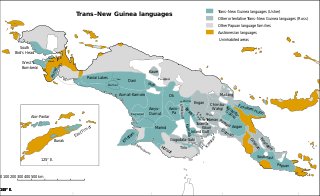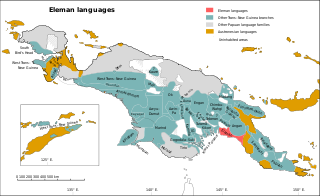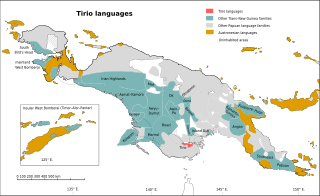Related Research Articles

Trans–New Guinea (TNG) is an extensive family of Papuan languages spoken on the island of New Guinea and neighboring islands ‒ corresponding to the country Papua New Guinea as well as parts of Indonesia.

The Papuan languages are the non-Austronesian and non-Australian languages spoken on the western Pacific island of New Guinea in Indonesia and Papua New Guinea, as well as neighbouring islands, by around 4 million people. It is a strictly geographical grouping, and does not imply a genetic relationship. The concept of Papuan (non-Austronesian) speaking Melanesians as distinct from Austronesian-speaking Melanesians was first suggested and named by Sidney Herbert Ray in 1892.
The Sko or Skou languages are a small language family spoken by about 7000 people, mainly along the Vanimo coast of Sandaun Province in Papua New Guinea, with a few being inland from this area and at least one just across the border in the Indonesian province of Papua.
The East Papuan languages is a defunct proposal for a family of Papuan languages spoken on the islands to the east of New Guinea, including New Britain, New Ireland, Bougainville, Solomon Islands, and the Santa Cruz Islands. There is no evidence that these languages are related to each other, and the Santa Cruz languages are no longer recognized as Papuan.
Tayap is an endangered Papuan language spoken by fewer than 50 people in Gapun village of Marienberg Rural LLG in East Sepik Province, Papua New Guinea. It is being replaced by the national language and lingua franca Tok Pisin.

Karkar Island is an oval-shaped volcanic island located in the Bismarck Sea, about 30 kilometres off the north coast of mainland Papua New Guinea in Madang Province, from which it is separated by the Isumrud Strait. The island is about 25 km in length and 19 km in width. In the centre is an active volcano with two nested calderas.
The Karkar language, also known as Yuri, is the sole Eastern Pauwasi language of Papua New Guinea. There are about a thousand speakers along the Indonesian border spoken in Green River Rural LLG, Sandaun Province.

The South Bougainville or East Bougainville languages are a small language family spoken on the island of Bougainville in Papua New Guinea. They were classified as East Papuan languages by Stephen Wurm, but this does not now seem tenable, and was abandoned in Ethnologue (2009).
Takia is an Austronesian language spoken on Karkar Island, Bagabag Island, and coastal villages Megiar and Serang, Madang Province, Papua New Guinea. It has been syntactically restructured by Waskia, a Papuan language spoken on the island.
The Pauwasi languages are a likely family of Papuan languages, mostly in Indonesia. The subfamilies are at best only distantly related. The best described Pauwasi language is Karkar, across the border in Papua New Guinea. They are spoken around the headwaters of the Pauwasi River in the Indonesian-PNG border region.

The Eleman languages are a family spoken around Kerema Bay, Papua New Guinea.

The Tirio languages are a family of Trans–New Guinea languages in the classification of Malcolm Ross. The Tirio languages have about 40% of their lexicon in common.
The Northern Adelbert or Pihom–Isumrud languages are a family of two dozen languages in the Madang stock of New Guinea. The occupy the coastal northern Adelbert Range of mountains, vs. the Southern Adelbert languages, another branch of Madang.
The Kowan languages are a small family of languages spoken in the Adelbert Range area of Madang Province, Papua New Guinea, and first identified by Malcolm Ross.
Hatam is a divergent language spoken on the island of New Guinea, specifically in the Indonesian province of West Papua.
Pamosu is a Papuan language of Madang Province, Papua New Guinea. Some of the older generations speak Pal, a related language. It is currently being documented by Andrew Pick.
Brem (Barem), also known as Bunabun, is a Papuan language of Sumgilbar Rural LLG, Madang Province, Papua New Guinea.
Manep is a Papuan language of Sumgilbar Rural LLG, Madang Province, Papua New Guinea.
Yamben (Yaben) is a Trans–New Guinea language of Madang Province, Papua New Guinea. It was first documented by Andrew Pick in the 2010s and classified by Pick (2019) as a probable primary branch of Madang, though its precise classification is still pending further research. Although surrounded by Croisilles languages, Yamben is not one of them.
Proto-Trans–New Guinea is the reconstructed proto-language ancestral to the Trans–New Guinea languages. Reconstructions have been proposed by Malcolm Ross and Andrew Pawley.
References
- ↑ Waskia at Ethnologue (18th ed., 2015) (subscription required)
- ↑ United Nations in Papua New Guinea (2018). "Papua New Guinea Village Coordinates Lookup". Humanitarian Data Exchange. 1.31.9.
- ↑ Pick, Andrew (2019). "Gildipasi language project: tumbuna stories and tumbuna knowledge". Endangered Languages Archive at SOAS, University of London.